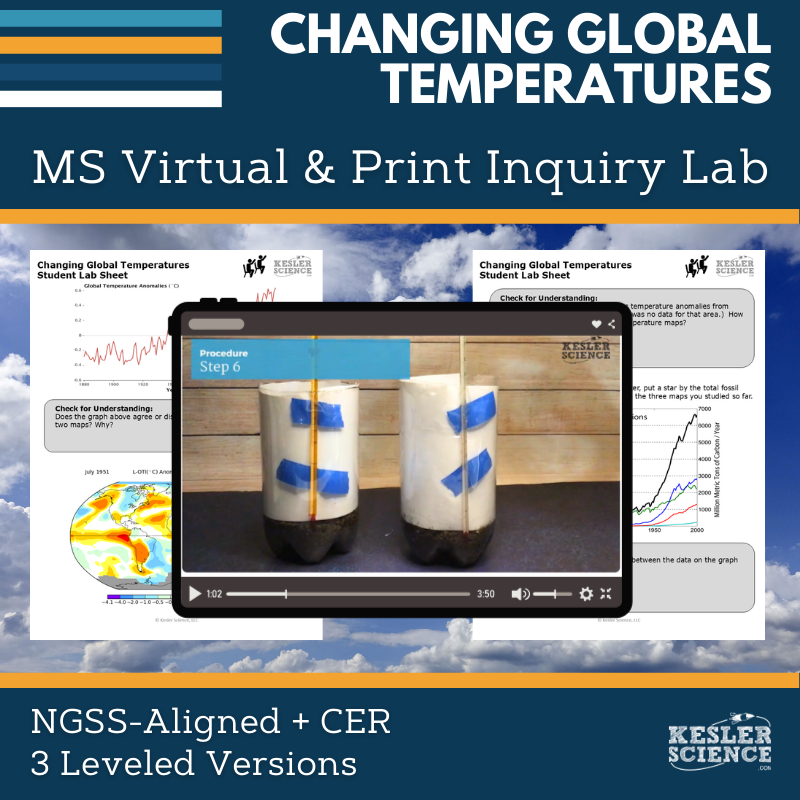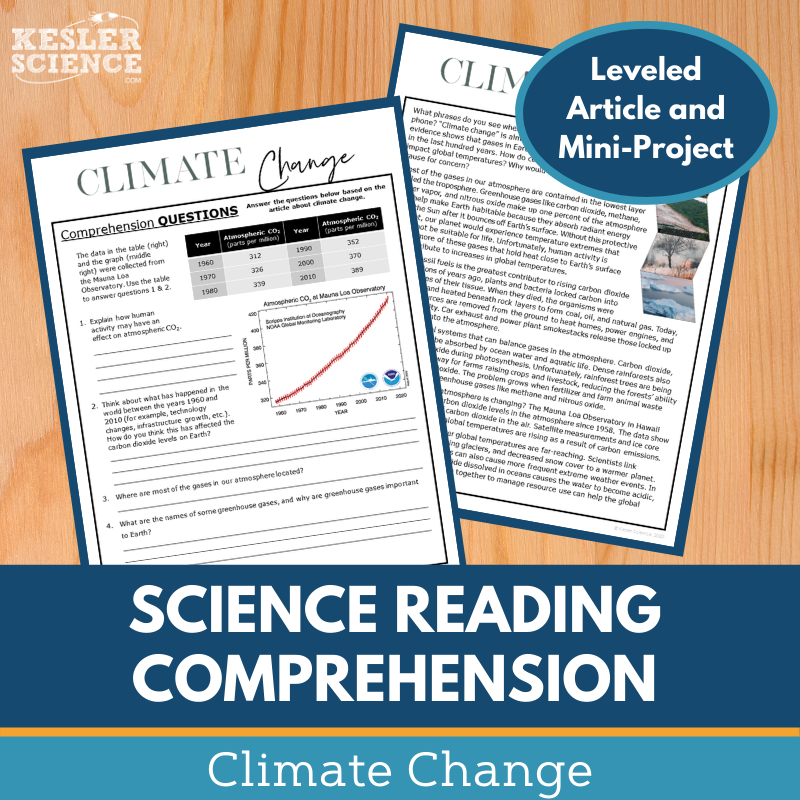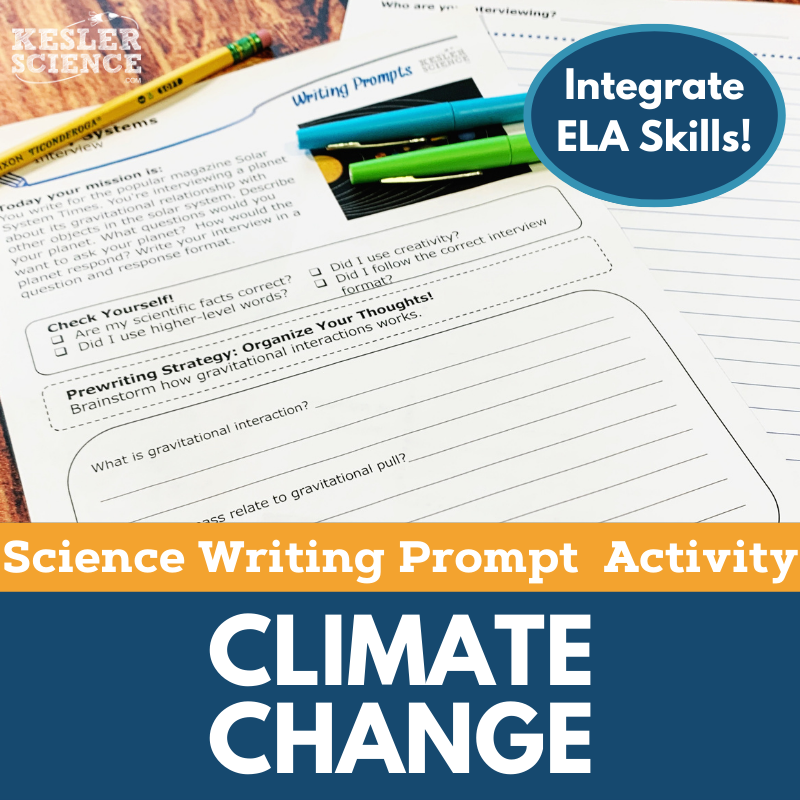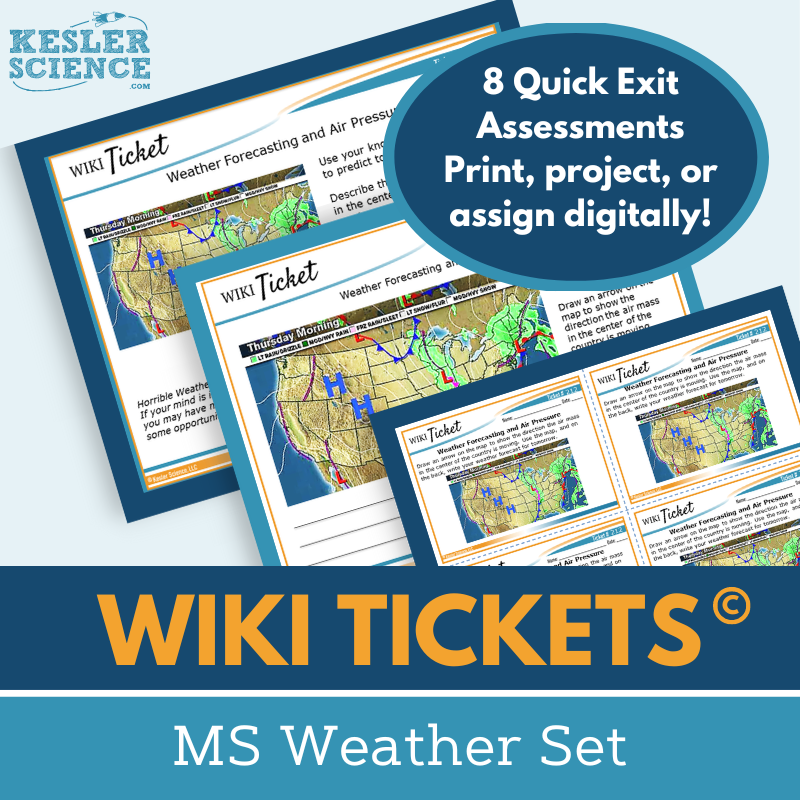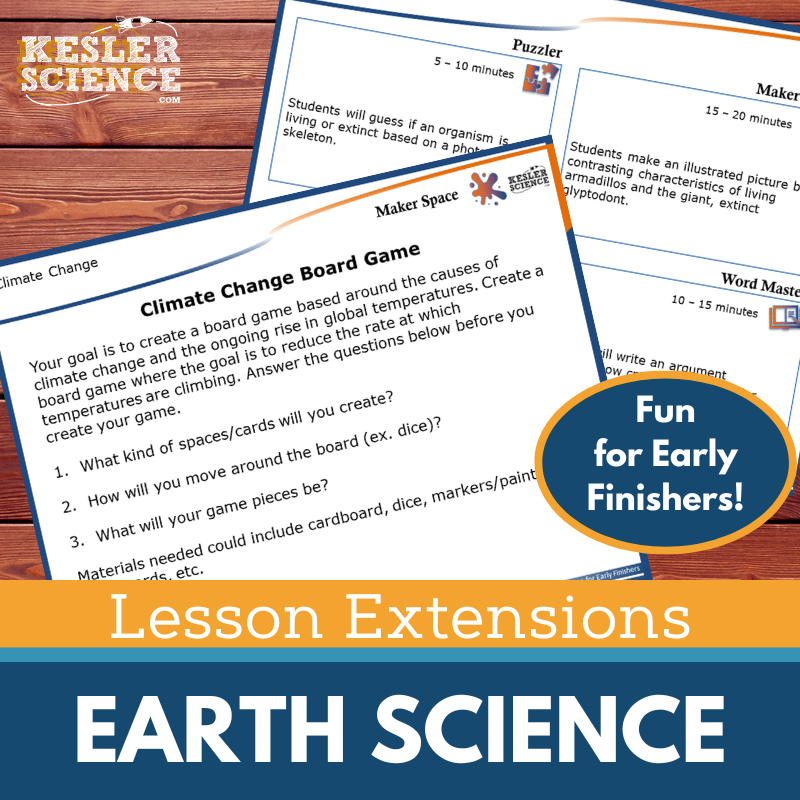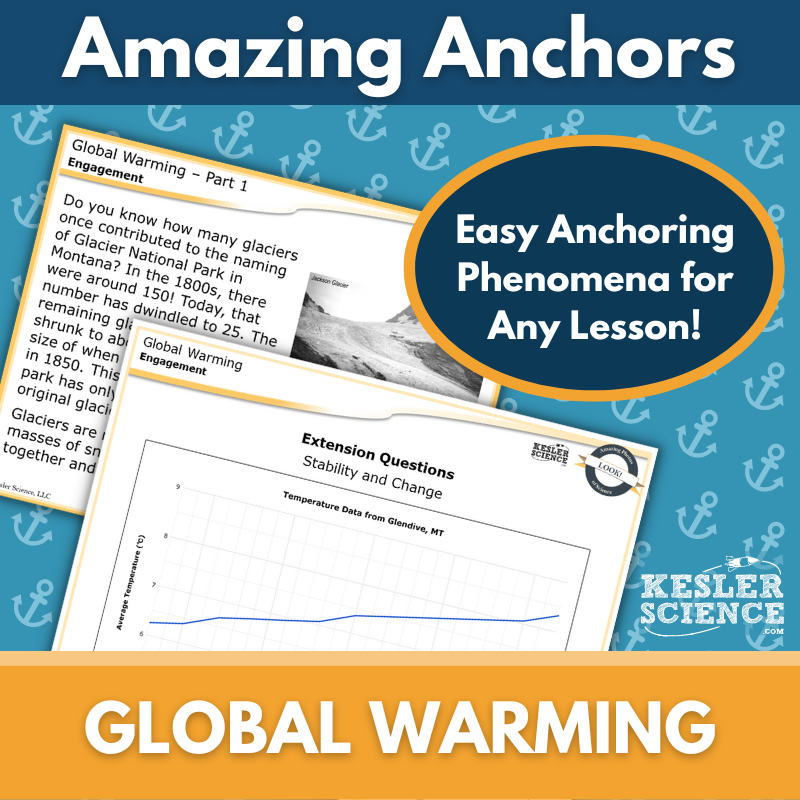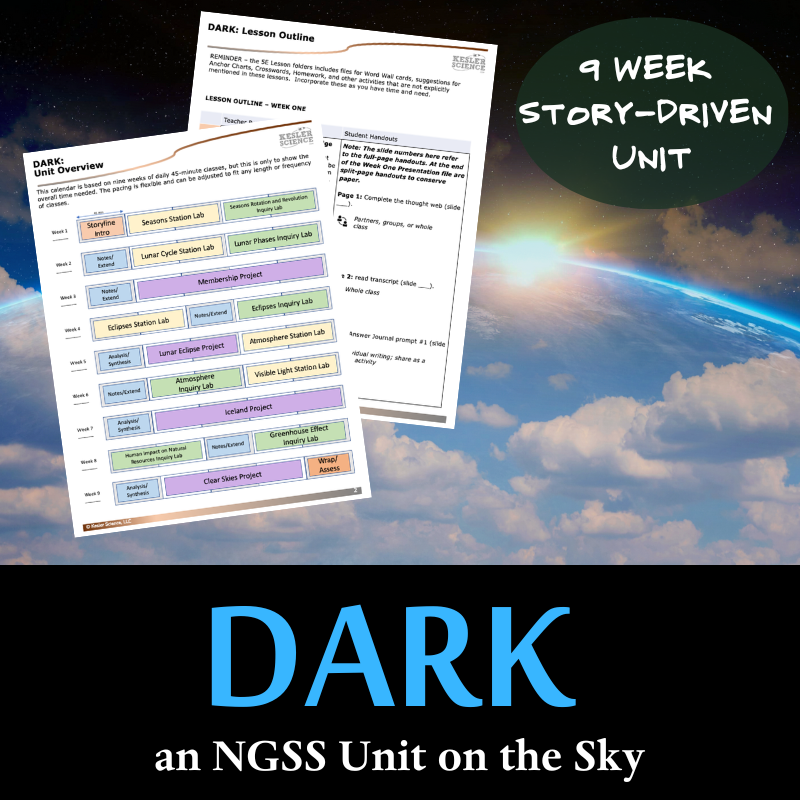Changing Global Temperatures Activities for Middle School Science
These NGSS-aligned activities engage students in exploring climate change through hands-on labs, reading comprehension, data analysis, and writing exercises. The resources below will give students a comprehensive understanding of changing global temperatures. All of the following materials are also included in the Kesler Science Membership.
The Changing Global Temperatures Inquiry Lab aligns with NGSS MS-ESS3-5, guiding students to analyze evidence of factors contributing to rising global temperatures. Students model the effects of greenhouse gases, interpret graphs and maps, and evaluate carbon dioxide’s role in climate change.
This flexible lab includes both a hands-on print version and a fully interactive digital format. The print lab provides step-by-step procedures for in-person experimentation, while the digital version features an interactive PowerPoint compatible with Google Slides, along with a video demonstration of the lab. Both formats include comprehension questions, C.E.R. prompts, and reflection sections.
Differentiation is built in with three levels: a dependent version with guided inquiry, a modified version with structured support, and an independent version for advanced learners. Editable PowerPoints allow customization, and teacher resource pages simplify planning with answer keys, objectives, and materials lists. Whether printed or digital, this lab provides an engaging, student-centered approach to exploring climate science.
The Changing Global Temperatures Inquiry Lab aligns with NGSS MS-ESS3-5, guiding students to analyze evidence of factors contributing to rising global temperatures. Students model the effects of greenhouse gases, interpret graphs and maps, and evaluate carbon dioxide’s role in climate change.
This flexible lab includes both a hands-on print version and a fully interactive digital format. The print lab provides step-by-step procedures for in-person experimentation, while the digital version features an interactive PowerPoint compatible with Google Slides, along with a video demonstration of the lab. Both formats include comprehension questions, C.E.R. prompts, and reflection sections.
Differentiation is built in with three levels: a dependent version with guided inquiry, a modified version with structured support, and an independent version for advanced learners. Editable PowerPoints allow customization, and teacher resource pages simplify planning with answer keys, objectives, and materials lists. Whether printed or digital, this lab provides an engaging, student-centered approach to exploring climate science.
This Climate Change Science Reading Comprehension Lesson helps students explore Earth and human activity through a nonfiction article. Designed for middle school, the leveled passage supports science literacy and reading comprehension. Students answer five to seven comprehension questions and create an ecoregion map highlighting areas affected by climate change.
The resource includes two leveled articles (Lexile 1100-1300), a mini-project, and a Cornell notes template. It features engaging graphics that print easily in grayscale and is compatible with Google Classroom, MS Teams, Schoology, and Canvas for virtual learning.
Ideal for sub plans, ISS, extra credit, or whole-class instruction, this resource fosters critical thinking, classroom discussions, and textual analysis while reinforcing key science concepts.
This Climate Change Science Reading Comprehension Lesson helps students explore Earth and human activity through a nonfiction article. Designed for middle school, the leveled passage supports science literacy and reading comprehension. Students answer five to seven comprehension questions and create an ecoregion map highlighting areas affected by climate change.
The resource includes two leveled articles (Lexile 1100-1300), a mini-project, and a Cornell notes template. It features engaging graphics that print easily in grayscale and is compatible with Google Classroom, MS Teams, Schoology, and Canvas for virtual learning.
Ideal for sub plans, ISS, extra credit, or whole-class instruction, this resource fosters critical thinking, classroom discussions, and textual analysis while reinforcing key science concepts.
The Climate Change Science Writing Prompt Activity engages middle school students in an interactive interview-style writing exercise to reinforce their understanding of climate change. Aligned with NGSS MS-ESS3-5, this activity encourages students to ask questions and clarify evidence about factors contributing to rising global temperatures. Designed for both in-person and virtual learning, it supports science reasoning and exploration while enhancing writing skills.
This resource includes teacher directions with answer guides and rubrics, projection and print handouts in both full-sized and half-sheet formats, and a digital PowerPoint version compatible with Google Slides. It works well as a cross-curricular activity, pre-test assessment, student choice project, elaboration for early finishers, extra credit, make-up work, TELPAS sample, or differentiation exercise. Additionally, students' work can be displayed on a bulletin board or compiled into an anthology. This writing prompt assumes students have prior knowledge of the topic or access to research materials.
The Climate Change Science Writing Prompt Activity engages middle school students in an interactive interview-style writing exercise to reinforce their understanding of climate change. Aligned with NGSS MS-ESS3-5, this activity encourages students to ask questions and clarify evidence about factors contributing to rising global temperatures. Designed for both in-person and virtual learning, it supports science reasoning and exploration while enhancing writing skills.
This resource includes teacher directions with answer guides and rubrics, projection and print handouts in both full-sized and half-sheet formats, and a digital PowerPoint version compatible with Google Slides. It works well as a cross-curricular activity, pre-test assessment, student choice project, elaboration for early finishers, extra credit, make-up work, TELPAS sample, or differentiation exercise. Additionally, students' work can be displayed on a bulletin board or compiled into an anthology. This writing prompt assumes students have prior knowledge of the topic or access to research materials.
These WIKI Tickets© formative assessments provide engaging, flexible options to quickly assess 6th-8th grade student understanding of weather-related science topics. The Weather Set includes eight topics, each available in five formats: a full-screen projection version, three printable handouts (full-page, split-page, and quarter-page), and an interactive digital version compatible with PowerPoint and Google Slides.
Aligned with middle school NGSS and TEKS standards, topics covered include catastrophic events, the greenhouse effect, natural hazards, ocean current patterns, oceans and weather systems, the water cycle, weather maps, and wind patterns. Ideal for exit tickets, bellringers, or quick checks, these assessments can be effectively used in both in-person and virtual learning environments.
These WIKI Tickets© formative assessments provide engaging, flexible options to quickly assess 6th-8th grade student understanding of weather-related science topics. The Weather Set includes eight topics, each available in five formats: a full-screen projection version, three printable handouts (full-page, split-page, and quarter-page), and an interactive digital version compatible with PowerPoint and Google Slides.
Aligned with middle school NGSS and TEKS standards, topics covered include catastrophic events, the greenhouse effect, natural hazards, ocean current patterns, oceans and weather systems, the water cycle, weather maps, and wind patterns. Ideal for exit tickets, bellringers, or quick checks, these assessments can be effectively used in both in-person and virtual learning environments.
Lesson Extensions provide engaging, student-choice activities designed to challenge fast finishers and enrich their understanding of earth science. These rigorous yet enjoyable activities fill downtime, reinforce critical thinking, and encourage independent learning aligned with NGSS and TEKS standards.
Each extension includes four interactive components: Puzzler for problem-solving, Maker Space for hands-on STEAM activities, Tech Connection for digital media demonstrations, and Word Master for creative science writing. Teacher directions, answer keys, and both projection and print versions (full- and half-sheet sizes) are included, making these extensions ideal for lesson wrap-ups, enrichment periods, or independent exploration.
Topics covered include circulation and climate, climate change, Earth's changing surface, fossil fuel distribution, the geological time scale, the plate tectonic theory, rock formation, weather changes, and more, ensuring comprehensive earth science enrichment.
Lesson Extensions provide engaging, student-choice activities designed to challenge fast finishers and enrich their understanding of earth science. These rigorous yet enjoyable activities fill downtime, reinforce critical thinking, and encourage independent learning aligned with NGSS and TEKS standards.
Each extension includes four interactive components: Puzzler for problem-solving, Maker Space for hands-on STEAM activities, Tech Connection for digital media demonstrations, and Word Master for creative science writing. Teacher directions, answer keys, and both projection and print versions (full- and half-sheet sizes) are included, making these extensions ideal for lesson wrap-ups, enrichment periods, or independent exploration.
Topics covered include circulation and climate, climate change, Earth's changing surface, fossil fuel distribution, the geological time scale, the plate tectonic theory, rock formation, weather changes, and more, ensuring comprehensive earth science enrichment.
This Amazing Anchors Phenomenon Lesson introduces global warming through a real-world connection to Glacier National Park. It includes an introductory reading with comprehension and extension questions to prepare students for deeper learning, followed by an explanatory reading that breaks down the science behind global warming in an accessible way, with additional reinforcement questions.
Aligned with NGSS standard MS ESS3-5, this no-prep resource includes teacher directions, answer keys, projection slides, and both print and digital formats for Google Classroom and other LMS platforms. A differentiated version provides sentence starters to support student comprehension. Designed to bookend a lesson, these engaging readings serve as supplements to reinforce learning in any in-person or virtual classroom.
This Amazing Anchors Phenomenon Lesson introduces global warming through a real-world connection to Glacier National Park. It includes an introductory reading with comprehension and extension questions to prepare students for deeper learning, followed by an explanatory reading that breaks down the science behind global warming in an accessible way, with additional reinforcement questions.
Aligned with NGSS standard MS ESS3-5, this no-prep resource includes teacher directions, answer keys, projection slides, and both print and digital formats for Google Classroom and other LMS platforms. A differentiated version provides sentence starters to support student comprehension. Designed to bookend a lesson, these engaging readings serve as supplements to reinforce learning in any in-person or virtual classroom.
"Explories: DARK" is an NGSS unit that combines a real-world storyline with Kesler Science inquiry labs, station labs, and 5E lessons. Students will join the fictional Amateur Astronomers’ Conservation Society, where they will investigate the Sun, the Moon, and Earth’s relationships and analyze atmospheric changes that impact the future.
This unit provides day-by-day teacher instructions, four unit projects, five station labs, six inquiry labs, and five 5E lessons. It includes student activity pages, project-based and traditional assessments, rubrics for standards-based grading, journaling activities, and two training videos.
Aligned with NGSS standards MS-ESS3-4 and MS-ESS3-5, students will construct evidence-based arguments on the human impact on Earth's systems and explore factors contributing to global temperature rise. Through engaging activities such as modeling celestial relationships, studying eclipses, reducing light pollution, and investigating atmospheric changes, students will experience the sky like never before.
"Explories: DARK" is an NGSS unit that combines a real-world storyline with Kesler Science inquiry labs, station labs, and 5E lessons. Students will join the fictional Amateur Astronomers’ Conservation Society, where they will investigate the Sun, the Moon, and Earth’s relationships and analyze atmospheric changes that impact the future.
This unit provides day-by-day teacher instructions, four unit projects, five station labs, six inquiry labs, and five 5E lessons. It includes student activity pages, project-based and traditional assessments, rubrics for standards-based grading, journaling activities, and two training videos.
Aligned with NGSS standards MS-ESS3-4 and MS-ESS3-5, students will construct evidence-based arguments on the human impact on Earth's systems and explore factors contributing to global temperature rise. Through engaging activities such as modeling celestial relationships, studying eclipses, reducing light pollution, and investigating atmospheric changes, students will experience the sky like never before.
Year-Round Resources
These year-round activities will increase your students' understanding of many middle school science topics. All of these activities are also included in the Kesler Science Membership.
Visual Data & Graphing
You're not alone if your students struggle with understanding graphs, charts, and tables. It's a skill that takes an enormous amount of practice. This resource will help students build a strong foundation in analyzing data and creating their own data visualizations.
Bell Ringers and Warm-Ups
These middle school science bell ringers are an excellent way to engage your students as soon as they walk into your classroom. This comprehensive FULL YEAR resource includes everything you need to start off each science class with an interesting warm-up activity.
Review Board Games
Each game board has been carefully designed to keep students engaged. There are 10 different action spaces on each board and dozens of question cards. All of the actions are related to science concepts and keep the students motivated throughout the game.
Each game is ready to play. Simply print out the board and the cards and let the students enjoy reviewing nine different units.
Essential Questions and Standards
Below are the essential questions and standards associated with the lessons and activities included in the changing global temperatures unit. This topic is only one of more than 100 middle school science topics included in the Kesler Science Membership.
-
What evidence is there for carbon dioxide as the cause of increasing global temperatures?
-
NGSS - MS-ESS3-5 Changing Global Temperatures
Kesler Science Membership
Imagine never having to search for another middle school science lesson again. The membership gives you access to ALL of the Kesler Science products in one place (Yes, including everything above).
Say goodbye to long hours of lesson prep.

